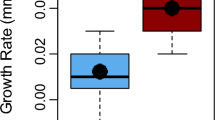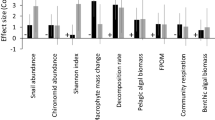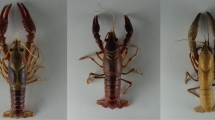Abstract
Ecosystems today increasingly suffer invasions by multiple invasive species. Complex interactions between invasive species can have different fitness implications for each invader, which can in turn determine the future progression of their invasions and result in differential impacts on native species and ecosystems. To this end, through pair-wise and group scale experiments, we examined possible interaction outcomes, competition effects and their potential fitness implications for two widespread invasive species of crayfish that increasingly co-occur in freshwater ecosystems of Europe (Pacifastacus leniusulus and Orconectes limosus). In all trials, P. leniusculus demonstrated the potential to outcompete O. limosus in both staged encounters and direct resource competition, being more likely to win heterospecific agonistic encounters and to acquire shelters at a higher rate. Observed dyadic dominance was translated to a broader social context of group-scale experiments, in which dominance of P. leniusculus was further strengthened by size differential between species. O. limosus was not able to compensate for competitive pressure by the dominant P. leniusculus and suffered wet weight loss and more frequent injuries in the presence of P. leniusculus. While both species are detrimental to native ecosystems, the ability of P. leniusculus to withstand competition pressure from another successful invasive species underscores its potential to establish dominant populations. Our results highlight the importance of understanding interspecies competition in prioritizing potential management activities or control efforts in contact zones.




Similar content being viewed by others
References
Adams M, Pearl C, Bruce Bury R (2003) Indirect facilitation of an anuran invasion by non-native fishes. Ecol Lett 6:343–351. doi:10.1046/j.1461-0248.2003.00435.x
Alonso F, Martinez R (2006) Shelter competition between two invasive crayfish species: a laboratory study. Bull Fr Peche Piscic 380–381:1121–1132. doi:10.1051/kmae:2006015
Angeler D, Sánchez-Carrillo S, García G et al (2001) The influence of Procambarus clarkii (Cambaridae, Decapoda) on water quality and sediment characteristics in a Spanish floodplain wetland. Hydrobiologia 464:89–98. doi:10.1023/A:1013950129616
Bergman D, Moore P (2003) Field observations of intraspecific agonistic behavior of two crayfish species, Orconectes rusticus and Orconectes virilis, in Different Habitats. Biol Bull 205:26–35
Berry F, Breithaupt T (2010) To signal or not to signal? Chemical communication by urine-borne signals mirrors sexual conflict in crayfish. BCM Biol 8:25. doi:10.1186/1741-7007-8-25
Blank GS, Figler MH (1996) Interspecific shelter competition between the sympatric crayfish species Procambarus clarkii (Girard) and Procambarus zonangulus (Hobbs and Hobbs). J Crust Biol 16:300–309
Bovbjerg R (1953) Dominance order in the crayfish Orconectes virilis (Hagen). Physiol Zool 26:173–178
Bovbjerg R (1956) Some factors affecting aggressive behavior in crayfish. Physiol Zool 29:127–136
Bovbjerg RV (1970) Ecological isolation and competitive exclusion in two crayfish (Orconectes virilis and Orconectes immunis). Ecology 51:225–236. doi:10.2307/1933658
Branch GM, Odendaal F, Robinson TB (2010) Competition and facilitation between the alien mussel Mytilus galloprovincialis and indigenous species: moderation by wave action. J Exp Mar Biol Ecol 383:65–78. doi:10.1016/j.jembe.2009.10.007
Breithaupt T, Eger P (2002) Urine makes the difference: chemical communication in fighting crayfish made visible. J Exp Biol 205:1221–1231
Bruski C, Dunham D (1987) The importance of vision in agonistic communication of the crayfish Orconectes rusticus. Behaviour 103:83–107. doi:10.1163/156853987X00288
Capelli GM, Munjal BL (1982) Aggressive interactions and resource competition in relation to species displacement among crayfish of the genus Orconectes. J Crustac Biol 2:486–492. doi:10.2307/1548090
Cope N, Winterbourn M (2004) Competitive interactions between two successful molluscan invaders of freshwaters: an experimental study. Aquat Ecol 38:83–91. doi:10.1023/B:AECO.0000021018.20945.9d
Corkum LD, Cronin DJ (2004) Habitat complexity reduces aggression and enhances consumption in crayfish. J Ethol 22:23–27. doi:10.1007/s10164-003-0095-x
Davis K, Huber R (2007) Activity patterns, behavioural repertoires, and agonistic interactions of crayfish: a non-manipulative field study. Behaviour 144:229–247. doi:10.1163/156853907779947300
Diéguez-Uribeondo J (2006) The dispersion of the Aphanomyces astaci-carrier Pacifastacus leniusculus by humans represents the main cause of disappearance of the indigenous crayfish Austropotamobius pallipes in Navarra. Bull Fr Peche Piscic 380–381:1303–1312. doi:10.1051/kmae:2006036
Edsman L, Jonsson A (1996) The effect of size, antennal injury, ownership, and ownership duration on fighting success in male signal crayfish, Pacifastacus leniusculus (Dana). Nord J Freshwat Res 72:80–87
Fero K, Simon JL, Jourdie V et al (2007) Consequences of social dominance on crayfish resource use. Behaviour 144:61–82. doi:10.1163/156853907779947418
Figler M, Blank G, Peeke H (2005) Shelter competition between resident male red swamp crayfish Procambarus clarkii (Girard) and conspecific intruders varying by sex and reproductive status. Mar Freshwat Behav Physiol 38:237–248. doi:10.1080/10236240500376477
Freeman M, Turnbull J, Yeomans W et al (2009) Prospects for management strategies of invasive crayfish populations with an emphasis on biological control. Aquat Conserv: Mar Freshwat Ecosyst 20:211–223. doi:10.1002/aqc.1065
Garvey J, Stein R, Thomas H (1994) Assessing how fish predation and interspecific prey competition influence a crayfish assemblage. Ecology 75:532–547. doi:10.2307/1939556
Gherardi F (2002) Behaviour. In: Holdich D (ed) Biology of freshwater crayfish. Blackwell Science, London, pp 258–281
Gherardi F (2007) Understanding the impact of invasive crayfish. In: Gherardi F (ed) Biological invaders in inland waters: profiles, distribution and threats. Springer, Netherlands, pp 507–542
Gherardi F, Cioni A (2004) Agonism and interference competition in freshwater decapods. Behaviour 141:1297–1324. doi:10.1163/1568539042729702
Gherardi F, Daniels WH (2004) Agonism and shelter competition between invasive and indigenous crayfish species. Can J Zool 82(12):1923–1932. doi:10.1139/z04-185
Graham M, Herberholz J (2009) Stability of dominance relationships in crayfish depends on social context. Anim Behav 77:195–199. doi:10.1016/j.anbehav.2008.09.027
Guan R, Wiles P (1996) Growth, density and biomass of crayfish, Pacifastacus leniusculus, in a British lowland river. Aquat Living Resour 9:265–272. doi:10.1051/alr:1996030
Guiasu RC, Dunham DW (1999) Aggressive interactions between the crayfishes Cambarus bartonii bartonii and C. robustus (Decapoda: Cambaridae): interspecific and intraspecific contests. J Crust Biol 19(1):131–146
Haertel-Borer SS, Zak D, Eckmann R et al (2005) Population density of the crayfish, Orconectes limosus, in relation to fish and macro invertebrate densities in a small mesotrophic lake—implications for the lake’s food web. Int Rev Hydrobiol 90:523–533. doi:10.1002/iroh.200510819
Hamr P (2002) Orconectes. In: Holdich D (ed) Biology of freshwater crayfish, 1st edn. Blackwell Science, London, pp 585–609
Hemsworth R, Villareal W, Patullo B et al (2007) Crustacean social behavioral changes in response to isolation. Biol Bull 213:187–195
Hill A, Lodge D (1994) Diel changes in resource demand: competition and predation in species replacement among crayfishes. Ecology 75:2118–2126. doi:10.2307/1941615
Hill A, Lodge D (1999) Replacement of resident crayfishes by an exotic crayfish: the roles of competition and predation. Ecol Appl 9:678–690. doi:10.1890/1051-0761(1999)009[0678:RORCBA]2.0.CO;2
Holdich D, Black J (2007) The spiny-cheek crayfish, Orconectes limosus (Rafinesque, 1817) [Crustacea: Decapoda: Cambaridae], digs into the UK. Aquat Invasions 2:1–16. doi:10.3391/ai.2007.2.1.1
Holdich D, Rogers W, Reader J et al (1995) Interactions between three species of freshwater crayfish (Austropotamobius pallipes, Astacus leptodactylus and Pacifastacus leniusculus). Freshw Crayfish 10:46–56
Huber R, Kravitz EA (1995) A quantitative analysis of agonistic behavior in juvenile american lobsters (Homarus americanus L.). Brain Behav Evol 46:72–83. doi:10.1159/000113260
Hudina S, Faller M, Lucic A et al (2009) Distribution and dispersal of two invasive crayfish species in the Drava River basin, Croatia. Knowl Manag Aquat Ecos 394–395:09. doi:10.1051/kmae/2009023
Johnson PTJ, Olden JD, Solomon CT et al (2009) Interactions among invaders: community and ecosystem effects of multiple invasive species in an experimental aquatic system. Oecologia 159:161–170. doi:10.1007/s00442-008-1176-x
Jordan NR, Larson DL, Huerd SC (2008) Soil modification by invasive plants: effects on native and invasive species of mixed-grass prairies. Biol Invasions 10:177–190. doi:10.1007/s10530-007-9121-1
Juanes F, Smith L (1995) The ecological consequences of limb damage and loss in decapod crustaceans: a review and prospectus. J Exp Mar Biol Ecol 193:197–223. doi:10.1016/0022-0981(95)00118-2
Klocker C, Strayer D (2004) Interactions among an invasive crayfish (Orconectes rusticus), a native crayfish (Orconectes limosus), and native bivalves (Sphaeriidae and Unionidae). Northeast Nat 11:167–178
Koch LM, Patullo BW, Macmillan DL (2006) Exploring with damaged antennae: do crayfish compensate for injuries? J Exp Biol 209:3226–3233. doi:10.1242/jeb.02368
Krzywosz T, Ulikowski D, Traczuk P (2006) Estimated population abundance of catchable signal crayfish (Pacifastacus leniusculus (Dana)) and spiny-cheek crayfish (Orconectes limosus (Raf.)) in Lake Pobledzie (Northeastern Poland). Arch Pol Fish 14:141–146
La Pierre KJ, Harpole WS, Suding KN (2010) Strong feeding preference of an exotic generalist herbivore for an exotic forb: a case of invasional antagonism. Biol Invasions. doi:10.1007/s10530-010-9693-z Online publication date: 20-Jan-2010
Lewis D (2001) Trade-offs between growth and survival: responses of freshwater snails to predacious crayfish. Ecology 82:758–765. doi:10.1890/0012-9658(2001)082[0758:TOBGAS]2.0.CO;2
Lewis S (2002) Pacifastacus. In: Holdich D (ed) Biology of freshwater crayfish, 1st edn. Blackwell Science, London, pp 511–534
Maezo M, Fournier H, Beisner B (2010) Potential and realized interactions between two aquatic invasive species: Eurasian watermill foil (Myriophyllum spicatum) and rusty crayfish (Orconectes rusticus). Can J Fish Aquat Sci 67:684–700. doi:10.1139/F10-016
Maiwald T, Schulz HK, Smietana P, Schulz R (2006) Aggressive interactions and interspecifc competition between the indigenous crayfish Astacus astacus (Linne) and the non-indigenous Orconectes limosus (Rafinesque). Freshwat crayfish 15:203–211
Martin AL, Moore PA (2008) The influence of dominance on shelter preference and eviction rates in the crayfish, Orconectes rusticus. Ethology 114:351–360. doi:10.1111/j.1439-0310.2008.01473.x
Matsuzaki SS, Usio N, Takamura N et al (2009) Contrasting impacts of invasive engineers on freshwater ecosystems: an experiment and meta-analysis. Oecologia 158:673–686. doi:10.1007/s00442-008-1180-1
Mills MD, Rader RB, Belk MC (2004) Complex interactions between native and invasive fish: the simultaneous effects of multiple negative interactions. Oecologia 141:713–721. doi:10.1007/s00442-004-1695-z
Nakata K, Goshima S (2003) Competition for shelter of preferred sizes between the native crayfish species Cambaroides japonicus and he alien crayfish species Pacifastacus leniusculus in Japan in relation to prior residence, sex difference, and body size. J Crust Biol 23:897–907. doi:10.1651/C-2411
Peay S, Hiley PD, Collen P et al (2006) Biocide treatment of ponds in Scotland to eradicate signal crayfish. Bull Fr Peche Piscic 380–381:1363–1379. doi:10.1051/kmae:2006041
Perry W, Lodge D, Lamberti G (2000) Crayfish (Orconectes rusticus) impacts on zebra mussel (Dreissena polymorpha) recruitment, other macroinvertebrates and algal biomass in a lake-outlet stream. Am Midl Nat 144:308–316. doi:10.1674/0003-0031(2000)144[0308:CORIOZ]2.0.CO;2
Pintor LM, Sih A (2009) Differences in growth and foraging behavior of native and introduced populations of an invasive crayfish. Biol Invasions 11:1895–1902. doi:10.1007/s10530-008-9367-2
Pintor LM, Sih A, Bauer M (2008) Differences in aggression, activity and boldness between native introduced populations of an invasive crayfish. Oikos 117(11):1629–1636. doi:10.1111/j.1600-0706.2008.16578.x
Pintor L, Sih A, Kerby J (2009) Behavioral correlations provide a mechanism for explaining high invasive densities and increased impact on native prey. Ecology 90:581–587. doi:10.1890/08-0552.1
Platvoet D, Dick JTA, MacNeil C et al (2009) Invader–invader interactions in relation to environmental heterogeneity leads to zonation of two invasive amphipods, Dikerogammarus villosus (Sowinsky) and Gammarus tigrinus Sexton: amphipod pilot species project (AMPIS) report 6. Biol Invasions 11:2085–2093. doi:10.1007/s10530-009-9488-2
Preisser E, Elkinton J (2008) Exploitative competition between invasive herbivores benefits a native host plant. Ecology 89:2671–2677. doi:10.1890/08-0299.1
Ricciardi A (2001) Facilitative interactions among aquatic invaders: is an invasional meltdown occurring in the great lakes? Can J Fish Aquat Sci 58:2513–2525. doi:10.1139/cjfas-58-12-2513
Riel MC, Velde G, Vaate A (2009) Interference competition between alien invasive gammaridean species. Biol Invasions 11:2119–2132. doi:10.1007/s10530-009-9486-4
Rius M, McQuaid CD (2009) Facilitation and competition between invasive and indigenous mussels over a gradient of physical stress. Basic Appl Ecol 10:607–613. doi:10.1016/j.baae.2009.03.008
Roessink I, Hudina S, Ottburg F (2009) Literaturstuudie naar de biologie, impact en mogelijke bestrijding van twee invasive soorten: de rode Amerikaanse rivierkreeft (Procambarus clarkii) en de geknobbelde Amerkaanse rivierkreeft (Orconectes virilis). Alterra Institute, The Netherlands
Rovero F (2000) Estimating the energetic cost of fighting in shore crabs by noninvasive monitoring of heartbeat rate. Anim Behav 59:705–713. doi:10.1006/anbe.1999.1353
Schroeder L, Huber R (2001) Fighting strategies in small and large individuals of the crayfish, Orconectes rusticus. Behaviour 128:1437–1449. doi:10.1163/156853901317367681
Schulz R, Smietana P (2001) Occurrence of native and introduced crayfish in Northeastern Germany and Northwestern Poland. Bull Fr Peche Piscic 361:629–641. doi:10.1051/kmae:2001009
Shea K, Chesson P (2002) Community ecology theory as a framework for biological invasions. Trends Ecol Evol 17:170–176. doi:10.1016/S0169-5347(02)02495-3
Sneddon L, Taylor A, Huntingford F (1999) Metabolic consequences of agonistic behaviour: crab fights in declining oxygen tensions. Anim Behav 57:353–363. doi:10.1006/anbe.1998.0982
Söderbäck B (1991) Interspecific dominance relationship and aggressive interactions in the freshwater crayfishes Astacus astacus (L.) and Pacifastacus leniusculus (Dana). Canad J Zool 69:1321–1325. doi:10.1139/z91-186
Söderbäck B (1994) Interactions among juveniles of two freshwater crayfish species and a predatory fish. Oecologia 100:229–235. doi:10.1007/BF00316949
Söderbäck B (1995) Replacement of the native crayfish Astacus astacus by the introduced species Pacifastacus leniusculus in a Swedish lake: possible causes and mechanisms. Freshwat Biol 33:291–304. doi:10.1111/j.1365-2427.1995.tb01168.x
Souty-Grosset C, Holdich D, Noel P et al (2006) Atlas of crayfish in Europe. Museum National d’Histoire Naturelle, Paris
Tierney A, Godleski M, Massanari J (2001) Comparative analysis of agonistic behavior in four crayfish species. J Crust Biol 20:54–66. doi:10.1651/0278-0372(2000)020[0054:CAOABI]2.0.CO;2
Usio N, Konishi M, Nakano S (2001) Species displacement between an introduced and a vulnerable crayfish: the role of aggressive interactions and shelter competition. Biol Invasions 3:179–185. doi:10.1023/A:1014573915464
Usio N, Kamiyama R, Saji A et al (2009) Size-dependent impacts of invasive alien crayfish on a littoral marsh community. Biol Conserv 142:1480–1490. doi:10.1016/j.biocon.2009.02.016
Vorburger C, Ribi G (1999) Aggression and competition for shelter between a native and an introduced crayfish in Europe. Freshwat Biol 42:111–119. doi:10.1046/j.1365-2427.1999.00465.x
Weis JS (2010) The role of behavior in the success of invasive crustaceans. Mar Freshwat Behav Physiol 43:83–98. doi:10.1080/10236244.2010.480838
Wilson E (1975) Sociobiology: the new synthesis. Harvard University Press, Cambridge
Zar J (1996) Biostatistical analyses. Prentice Hall, London
Acknowledgments
We thank Piet Verdonschot and Dorinne Dekkers for providing us with the Observer program, and Paul van Wielink, Jeffery Samuels and others for their help with acquiring P. leniusculus individuals. We are grateful to Kresimir Zganec for helpful comments and discussions on the manuscript. We would also like to thank two anonymous reviewers for their helpful comments and suggestions. This research was realized through a scholarship by the Wageningen Institute for Environment and Climate Research (WIMEK 2009/041).
Author information
Authors and Affiliations
Corresponding author
Rights and permissions
About this article
Cite this article
Hudina, S., Galić, N., Roessink, I. et al. Competitive interactions between co-occurring invaders: identifying asymmetries between two invasive crayfish species. Biol Invasions 13, 1791–1803 (2011). https://doi.org/10.1007/s10530-010-9933-2
Received:
Accepted:
Published:
Issue Date:
DOI: https://doi.org/10.1007/s10530-010-9933-2




